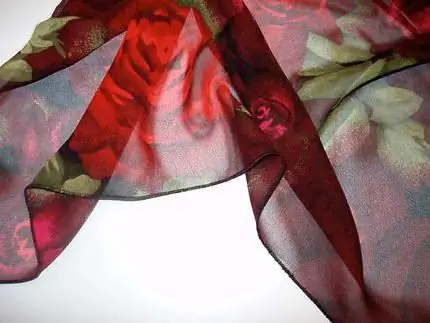
Inhaltsverzeichnis:
- Autor Sierra Becker [email protected].
- Public 2024-02-26 04:44.
- Zuletzt bearbeitet 2025-01-22 22:11.
Offene Partien auf dünnen Stoffen schön zu nähen kann ziemlich problematisch und schwierig sein, da das fließende Material bröckeln und buchstäblich in Ihren Händen „schweben“kann. Möchten Sie ein tolles Ergebnis in Form einer sauberen, elegant gef alteten Kante erzielen? Verwenden Sie dazu die Moskauer Naht. Betrachten Sie die Hauptphasen der Implementierung in Form einer Schritt-für-Schritt-Anleitung mit Fotos.

Moskauer Naht: Besonderheiten der Technologie und Ausführungsgeheimnisse
Diese Methode der Verarbeitung offener Schnitte eignet sich am besten für dünne Stoffe (Foto 1), die eine seltene und transparente Struktur haben. Beim Arbeiten mit solchen Stoffen kommt es häufig vor, dass der Saum mitsamt der Linie „entfernt“wird (insbesondere beim Einfassen einer Overlockkante). Daher muss eine spezielle Technologie verwendet werden. Das Grundprinzip der Arbeit ist eine doppelte Drehung und das Nähen fast „Naht auf Naht“. Die fertige Narbe fällt sehr schmal aus (nicht mehr als 3-4 mm) und macht das Produkt optisch nicht schwerer. Was ist das Geheimnis davonSchmuck, feine Arbeit? Die Moskauer Naht unterscheidet sich von anderen durch die spezielle Technologie der internen Verarbeitung. Der Punkt ist das Abschneiden eines freien Stoffabschnitts von der Kante fast in der Nähe der verlegten Linie. Dann, nach der zweiten Kurve, wird neben oder über der ersten eine abschließende Moskauer Naht ausgeführt. Das Schema in fertiger Form ist wie folgt: Auf der falschen Seite entlang der Kante befinden sich zwei Abschlusslinien (fast gleichmäßig) und auf der Vorderseite befindet sich eine.
Stufe eins: Saum und Nähen
- Stoff vorbügeln.
- Leinwandrand ggf. zerzaust in Form einer Franse abschneiden.
- Lege das Material mit der Vorderseite nach unten.
- Rand 9-10mm einschlagen.
- Nähe dicht am Rand zusammennähen. Der Abstand dazu sollte nicht mehr als 2 mm betragen. Die Stichbreite ist Standard. Achten Sie darauf, dass sich die Leinwand nicht zusammenzieht.
Beginnen Sie auf diese Weise mit dem Nähen einer Moskauer Naht auf Chiffon, Seide und anderen luftigen Stoffen, vorausgesetzt, die Kante verläuft in einer gemeinsamen oder quer verlaufenden Richtung. Und wie soll man sich zum Beispiel verh alten, wenn man den Boden eines ausgestellten Rocks fertigstellt? Es ist notwendig, die Implementierung der ersten Stufe ein wenig zu erschweren. Dank zusätzlicher Aktionen wird das Ergebnis genauer und eleganter.

Erste Turnaround-Option
Eine etwas kompliziertere Art, die Anfangsphase des Wendens durchzuführen, ist besser zu verwenden, wenn der Stoff in einer schrägen Richtung geschnitten wird oder die Kante eine bogenförmige Form hat. Typischerweise tritt dieses Problem auf, wenn der Boden eines Kleides oder Rockes mit einem ausgestellten Schnitt verarbeitet wird. Zulagen fürDie Nähte bei solchen Modellen sind nicht länger als 1-1,5 cm, da die F alte am schrägen Abschnitt, selbst wenn sie leicht vergrößert ist, wellig ist. Um Genauigkeit zu erreichen, müssen Sie also eine vorläufige Linie entlang einer geraden, geraden Leinwand legen. Biegen Sie dann den Stoff und bügeln Sie ihn sofort, um die Form zu sichern (Foto 2). Machen Sie erst danach die erste Zeile, geleitet von Absatz 5 der oben beschriebenen ersten Stufe. In dieser etwas komplizierteren Version wird die Moskauer Naht bei der Herstellung von Lambrequins häufig an Vorhängen aus dünnen Stoffen ausgeführt, bei denen beim Schneiden unterschiedliche Fadenrichtungen auftreten.

Schritt zwei: Stoff zuschneiden
Beginnen wir auf der Innenseite der Naht. Schneiden Sie mit Hilfe einer scharfen Schere die Stofflücke von der Kante bis zur Linie fast dicht von der falschen Seite ab (Foto 3). Lassen Sie eine kleine Lücke, buchstäblich 1 mm. Das Endergebnis ist viel genauer, wenn die genähte Kante im Halbkreis am Zeigefinger der linken Hand gezogen wird und die rechte Hand die Schere steuert, während sie Unterstützung und Begrenzung spürt. Es ist wichtig, es zu diesem Zeitpunkt nicht zu übertreiben, um die Nahtlinie nicht versehentlich zu beschädigen, aber ein zu breiter Stoffrest ist auch nutzlos. Wie Sie sehen können, ist die Moskauer Naht ein ziemlicher Schmuck und eine mühsame Arbeit. Für die hochwertige Umsetzung sind neben Sorgf alt auch ein hervorragendes Auge und eine ruhige Hand gefragt. Nach dem Abschneiden des Saums können Sie wieder bügeln.

Stufe drei: zweites Nähen
- F alten Sie die Kante auf eine Breite von 2-2,5 mm,sodass sich die erste Zeile in der Mitte befindet.
- Maschinenstich "Nadel an Nadel" oder mehrere nebeneinander, 1-1,5 mm nach links zurückziehend. Versuchen Sie gleichzeitig, den Stoff etwas zu dehnen und Schräglauf zu vermeiden, insbesondere bei unterschiedlichen Richtungen des gemeinsamen Fadens (Foto 4).
Wenn wir diese Phase praktisch durchführen, können wir schlussfolgern, dass die Breite der fertigen Narbe von der Position der ersten Naht in Bezug auf die Stoffkante abhängt. Je besser also das Werkstück gefertigt wurde, desto besser wird das Ergebnis.
So, wir haben alle Feinheiten behandelt, wie man eine Moskauer Naht auf Chiffon, Seide oder jedem dünnen Stoff macht. Natürlich sind solche Nähte auch auf andere Materialien anwendbar (mit Ausnahme von sehr dichten) - Krepp, Satin, Kattun usw. Durch die Verwendung der beschriebenen Technologie können Sie Schnitte auch ohne Spezialwerkzeug sauber und schön verarbeiten Herstellung von Veredelungselementen von Produkten.
Empfohlen:
Wie erstelle ich eine Origami-Tasse - detaillierte Anleitung und Video
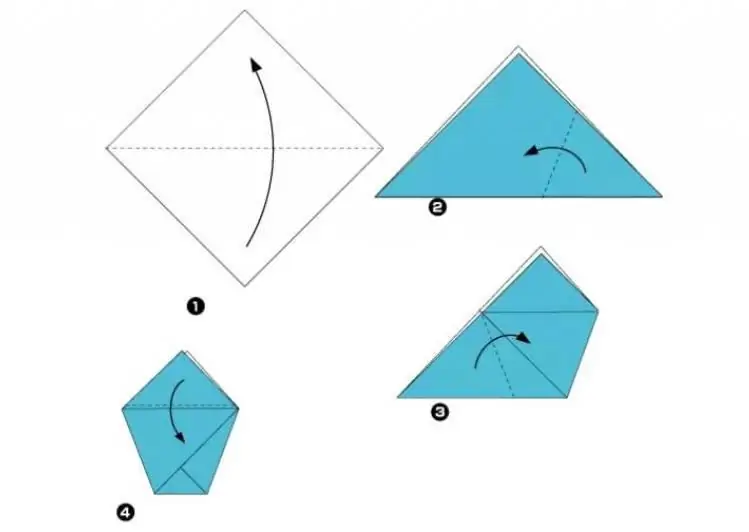
In diesem Artikel werden wir uns die Herstellung eines Origami-Pappbechers für Kinder genauer ansehen. Normalerweise wird das Blatt nach dem Schema gef altet, aber es ist auch bequem, sich ein Video anzusehen, in dem ein erfahrener Origami-Meister es geschickt zusammenbaut. In diesem Artikel stellen wir beide vor. Darüber hinaus kann ein Pappbecher aus einem gewöhnlichen dicken Blatt weißen Papiers für einen Drucker hergestellt sowie aus einer gewöhnlichen Notizbuchseite oder einem Blatt farbigen Papiers gef altet werden
Wie man einen Gummibanddiener webt: eine detaillierte Beschreibung und Anleitung

Beschreibung verschiedener Möglichkeiten, ein spezielles Armband in Form einer Figur aus dem Zeichentrickfilm "Ich – Einfach Unverbesserlich" zu weben - ein Günstling. Beschreibung des Webens mit eigenen Händen an der Maschine und mit Hilfe spezieller Gummibänder
Wie man eine Kapuze näht: Schnittmuster und ausführliche Anleitung. Wie man ein Kapuzenkragenmuster macht
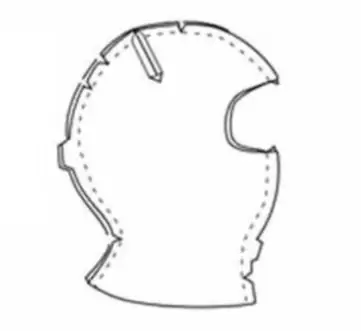
Moderne Mode bietet eine Vielzahl unterschiedlicher Arten von Kleidung. Viele Modelle sind mit dekorativen oder hochfunktionellen Kragen und Kapuzen ausgestattet. Die meisten Näherinnen, die eine Nähmaschine besitzen, würden gerne versuchen, ihre Kleidung mit solch einem niedlichen Detail zu veredeln. Allerdings weiß nicht jeder, wie man eine Kapuze näht. Das Muster scheint sehr kompliziert und die Arbeit ist fast unmöglich
Wie man mit eigenen Händen Haare für eine Puppe macht: eine Meisterklasse. Wie man Haare an eine Puppe näht
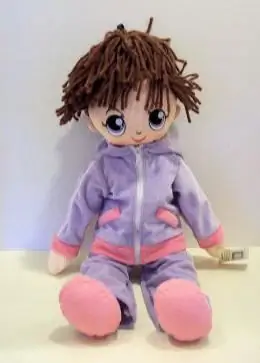
Dieser Artikel beschreibt alle möglichen Ideen und Möglichkeiten, um Haare für Textilpuppen und Puppen zu kreieren, die ihr Aussehen verloren haben. Haare für eine Puppe selbst zu machen ist viel einfacher als es auf den ersten Blick scheint, eine detaillierte Beschreibung hilft Ihnen dabei, dies sicherzustellen
Wie kann man einen Kissenbezug auf verschiedene Arten nähen? Detaillierte Anleitung
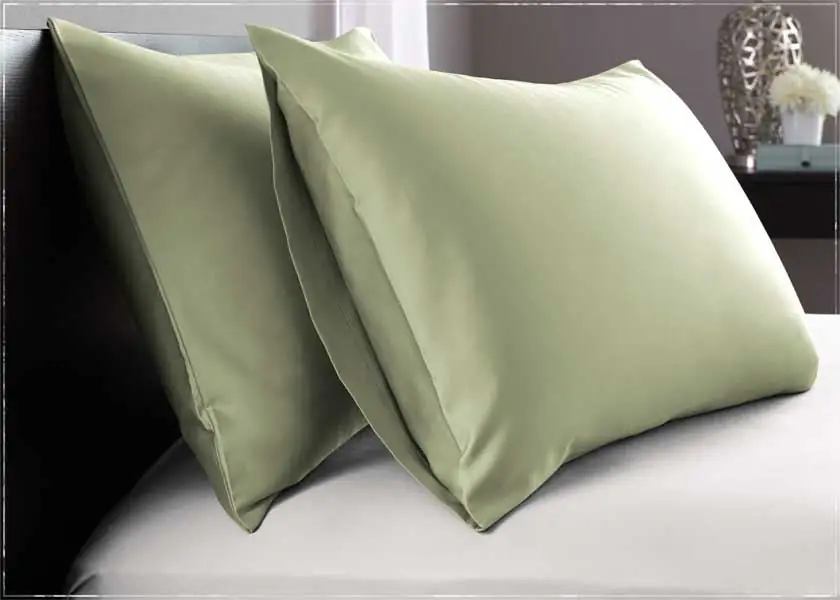
Kissenbezüge werden auf unterschiedliche Weise genäht. Dies ist ein Kissenbezug mit einem den Bewohnern unseres Landes vertrauten Geruch, ein Produkt mit verschiedenen Verschlüssen - einer Schlange, Knöpfen, Krawatten oder Klettverschlüssen. Es gibt mit einem Umschlag genähte Kissenbezüge, die auf der Rückseite in der Mitte mit einem Knopf befestigt werden. Wie Sie einen Kissenbezug selber nähen, erfahren Sie in unserem Artikel, der die verschiedenen Näharten ausführlich beschreibt
